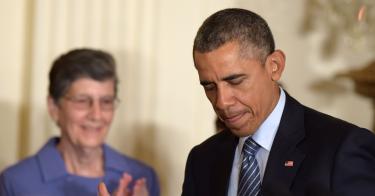The Trump administration is dismantling President Barack Obama’s climate legacy piece by piece, and this week it’s taking an axe to arguably the biggest piece.
In an expected move, Environmental Protection Agency Administrator Scott Pruitt officially began the process of rolling back the incorrectly named Clean Power Plan.
If the Trump administration is intent on achieving 3 percent economic growth and rescinding costly regulations that carry negligible climate benefits—and if it is concerned about preserving our energy grid—the Clean Power Plan is a must-go.
Under section 111(d) of the Clean Air Act, the Obama EPA formalized regulations to reduce carbon dioxide from existing power plants.
Using a name that surely message-tested well, the Clean Power Plan had nothing to do with eradicating hazardous pollutants from power generation. The U.S. already has laws on the books to protect Americans’ health from emissions that have adverse environmental impacts.
Instead, the Clean Power Plan regulated carbon dioxide, a colorless, odorless, nontoxic gas, because of its alleged contribution to climate change.
From Day One, Obama’s Clean Power Plan was fraught with problems—economically, environmentally, and legally.
For starters, families and businesses would have been hit with more expensive energy bills.
How so? The plan set specific limits on greenhouse gas emissions for each state based on the states’ electricity mix and offered “flexible” options for how states could meet the targets.
But no matter how states would have developed their plans, the economic damages would have been felt through higher energy costs, fewer job opportunities, and fewer energy choices for consumers.
The EPA’s idea of flexibility would not have softened the economic blow. It merely meant that Americans would have incurred higher costs through different mechanisms.
Environmentally, the climate impact of the Clean Power Plan would have been pointless. According to climatologist Paul Knappenberger:
Even if we implement the Clean Power Plan to perfection, the amount of climate change averted over the course of this century amounts to about 0.02 C. This is so small as to be scientifically undetectable and environmentally insignificant.
Legally, the Clean Power Plan was on shaky ground, to say the least. The regulation grossly exceeded the statutory authority of the EPA, violated the principles of cooperative federalism, and double-regulated existing power plants, which the Clean Air Act prohibits.
Take it from Laurence Tribe, Harvard University professor of constitutional law and a “liberal legal icon” who served in Obama’s Justice Department.
Tribe stated in testimony before Congress that the “EPA is attempting an unconstitutional trifecta: usurping the prerogatives of the states, Congress, and the federal courts—all at once. Burning the Constitution should not become part of our national energy policy.”
It’s no surprise that more than half the states in the country petitioned the Supreme Court to pause implementation of the regulation, and judges obliged, issuing a stay in 2016.
Pruitt, who led the charge against a rogue EPA as attorney general in Oklahoma, will respect the limits of the EPA as head of the agency. The EPA will now go through the formal rule-making and public comment period in order to repeal the Clean Power Plan.
What comes after that remains to be seen. State attorneys general in New York and Massachusetts, as well as environmental activist groups, are lining up to sue. The EPA could offer a far less stringent replacement regulation, which some industry groups are pushing for to buttress against lawsuits.
If members of Congress are fed up that policy continues to be made through the executive branch with a phone and a pen, they should step to the plate and legislate.
In this case, the solution is clear. The Clean Air Act was never intended to regulate carbon dioxide and other greenhouse gas emissions.
Congress should pass legislation prohibiting the EPA and other agencies from implementing harmful regulations that stunt economic growth and produce futile climate benefits.
This piece originally appeared in The Daily Signal


